Introduction
Wine isn’t just a drink—it’s a journey through terroir, history, people, and landscapes. For those who love wine, exploring the world’s great wine regions is about more than tasting; it’s about atmosphere, culture, and telling stories with each glass. Here are some of the top wine destinations that every wine lover should put on their bucket list.
1. Bordeaux, France – Legendary Reds, Timeless Châteaux
Nestled on the Gironde estuary, Bordeaux is arguably the gold standard in classic wine regions. Known for its powerful blends of Cabernet Sauvignon, Merlot, Cabernet Franc, and occasionally Petit Verdot and Malbec, Bordeaux wines are characterized by boldness, complexity, structure, and the ability to age gracefully.
- Must-sees: Châteaux in Médoc (Margaux, Pauillac), Saint-Émilion, Pomerol. The châteaux themselves are often architectural marvels.
- What to try: Left vs Right Bank blends; Sauternes for sweet white wine; the sharp minerality in Graves.
- When to go: Late spring or early autumn—the vineyards are lush, and the harvest period offers lots of activity.
2. Tuscany, Italy – Rolling Hills, Chianti Classico, Culture
Tuscany seamlessly blends wine with culture in a uniquely romantic way—encompassing olive groves, medieval hill towns, art, food, and wine. The Chianti Classico region, Brunello di Montalcino, and super-Tuscan blends provide depth, elegance, and character.
- Key varietals: Sangiovese dominates—fresh cherry, earth, tomato leaf, sometimes leather.
- Beyond wine: Try combining your wine tour with a stay in a rustic agriturismo, enjoy local trattorias, and explore towns like Siena, Florence, and Montepulciano.
3. Napa Valley, USA – California’s Signature Cabernet, Scenic Vineyards
If bold, sun-soaked Cabernets are your thing, Napa is your playground. Rolling vineyard views, gourmet restaurants, wine caves, and boutique tasting rooms make it a luxury wine region.
- Iconic wines: Cabernet Sauvignon, Chardonnay, and small-production experimental blends.
- Experience: Hot air balloon rides at dawn, vineyard tours, fine food pairings, and wine blending sessions.
4. Douro Valley, Portugal – Striking River Views, Robust Ports
The Douro Valley is dramatic—terraced vineyards along steep hillsides, often facing the Douro River. Famous for fortified Port wines, but also produces beautiful red and white table wines.
- Tasting notes: Rich, concentrated ports; dry reds with dark fruit, spice, sometimes smoky or mineral undertones.
- Things to do: River cruises, vintage wine lodges, historic quintas, and terrace walks.
5. Rioja, Spain – Iconic Tempranillo, Historic Wineries
Rioja offers a blend of deep tradition and evolving modern style. Tempranillo-based wines are usually aged—Crianza, Reserva, Gran Reserva—with oak influence.
- Old vs new: Traditional cellars with American oak vs modern wineries with French oak and innovative aging.
- Charming touch: The Rioja Alavesa region for beautiful landscapes; food is excellent—pintxos, grilled lamb, hearty stews.
6. Cape Winelands, South Africa – Blend of Tradition, Innovation, Chenin Blanc
Regions like Stellenbosch, Franschhoek, and Paarl are where classic European-style vineyards meet bold new world experimentation. Chenin Blanc, Pinotage, Shiraz, and Cabernet blends are strong.
- Scenery: Mountain-backed vineyards, Cape Dutch architecture, wine estates that double as gorgeous resorts.
- Bonus: The food scene is top-tier—fusion cuisine, fresh local seafood, farm-to-table concepts.
7. Marlborough, New Zealand – World-Class Sauvignon Blanc, Coastal Beauty
Marlborough put New Zealand on the world wine map, especially for Sauvignon Blanc. Vibrant aromas, crisp acidity, intense fruit—pretty much unmatched.
- Climate & terroir: Warm sunny days, cool nights, soil types that include gravel and alluvial clay—great for bright whites.
- Must-drinks: Passionfruit, lime, grapefruit notes; sometimes herbaceous touches. Oyster Bay, Cloudy Bay are well-known names.
8. Mendoza, Argentina – Malbec Paradise, Andean Scenery
High-altitude vineyards, spectacular mountain backdrops, and intense Malbec wines make Mendoza a must. The dry climate and bright sun help produce deeply colored wines with lush fruit, sometimes chocolate or violet notes.
9. Santorini, Greece – Volcanic Assyrtiko, Aegean Views
Santorini’s volcanic soil gives Assyrtiko a unique, sharp minerality, salinity, and freshness. The island’s cliffside vineyards, whitewashed buildings, and Aegean Sea views create a magical wine experience.
10. Launceston / Tamar Valley, Tasmania – Cool-Climate Pinot Noir, Boutique Charm
Tasmania, especially Launceston and the Tamar Valley, is a cooler-climate wine country. Pinot Noir, Chardonnay, and even sparkling wines do incredibly well here. Boutique vineyards, small-cellar-door tastings, and intimate wine experiences are the order of the day.
11. Alsace, France – Biodynamic Whites, Quaint Villages
Alsace combines exquisite white wines (Riesling, Gewürztraminer, Pinot Gris), charming villages with half-timbered houses, and a strong tradition of biodynamic/viticultural craftsmanship. Wines here can range from bone dry to lusciously sweet.
12. Valle de Guadalupe, Mexico – Creative, Underrated, Mediterranean Vibes
Just across the border from California, Valle de Guadalupe is emerging fast. Its climate has Mediterranean traits—warm days, cool nights—and winemakers are experimental. Think bold Reds, creative blends, and food pairing culture that matches the wine adventure.
Tips for Wine Travel & Making the Most of Each Destination
- Plan & book tastings: Some wineries require reservations, especially in peak season.
- Mix big estates with boutique producers: Big names are fantastic, but smaller vineyards often offer unique, personal stories.
- Time your visit: Harvest season is lively but busy; off-season gives more peace and room for reflection.
- Pair food & wine: Local food often brings out hidden qualities in regional wines. Toast with local cheeses, seafood, olives, and breads.
- Drama in terroir: Notice soil, sun exposure, proximity to water. These influence flavor enormously—from the volcanic soils of Santorini to the Andes’ high altitude in Mendoza.
Conclusion
These destinations are not just places on a map—they’re expressions of climate, culture, and patience. From the grandeur of Bordeaux’s châteaux to the volcanic cliffs of Santorini, each wine region has something to teach you. For those who love wine, exploring these best wine destinations isn’t just a journey—it’s a way to taste the world.


Recent Comments